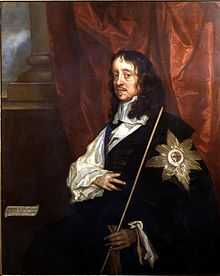Thomas Wriothesley, 4th Earl of Southampton
| Thomas Wriothesley | |
|---|---|
 Thomas Wriothesley, 4th Earl of Southampton | |
| Born | 10 March 1607 |
| Died | 16 May 1667 (aged 60) |
| Title | 4th Earl of Southampton |
| Tenure | 1624-1667 |
| Other titles |
Earl of Chichester Lord Wriothesley |
| Nationality | English |
| Offices | Lord High Treasurer |
| Predecessor | Henry Wriothesley, 3rd Earl of Southampton |
| Spouse(s) |
Rachel de Massue Lady Elizabeth Leigh Frances Seymour |
| Parents |
Henry Wriothesley, 3rd Earl of Southampton Elizabeth Vernon |
Thomas Wriothesley, 4th Earl of Southampton, KG (/ˈraɪəθsli/[1] REYE-əths-lee; 10 March 1607 – 16 May 1667), styled Lord Wriothesley before 1624, was a 17th-century English statesman, a staunch supporter of Charles II who would rise to the position of Lord High Treasurer after the English Restoration. His term as treasurer began concurrently with the assumption of power by the Clarendon Ministry, but his death would precede Lord Clarendon's impeachment from the House of Commons, after which the Cabal Ministry took over government.
Lord Southampton, having acceded to the earldom in 1624, attended St. John's College, Cambridge.[2] At first, he sided with the Parliament supporters upon the subjects leading to the English Civil War, but upon his realisation of their leaders' violence, he became a loyal supporter of Charles I. While remaining very loyal to the deposed monarch, he still vied for peace, representing the king at several peace conferences (as Encyclopædia Britannica notes, he attended at least two conferences: one in 1643, and one at Uxbridge in 1645). He was allowed to live within England, having paid the Commonwealth over £6000.
Several months after the Restoration, Lord Southampton was appointed Lord High Treasurer (8 September 1660), a position in which he would serve until his death. As the Encyclopædia Britannica notes, Lord Southampton "was remarkable for his freedom from any taint of corruption and for his efforts in the interests of economy and financial order," a noble if not completely objective view of his work as the keeper of the nation's finances.
Samuel Pepys admired Southampton's integrity and the stoicism with which he endured his painful last illness, but clearly had doubts about his competence as Treasurer; in particular he graphically described the Council meeting in April 1665 where Southampton helplessly asked him where he was to find the funds requested: "Why, what means all this, Mr. Pepys? This is true, you say, but what would you have me do? I have given all I can for my life. Why will not people lend their money?"[3] Against that, Pepys admitted that Sir William Coventry, the colleague he most admired, was in his turn an admirer of Southampton, whom he described as "a great statesman". Coventry recalled that other MInisters would joke that having said that it was "impossible" to find money, Southampton always did find it. Southampton however once grimly remarked that "Impossible will be found impossible at the last", an accurate prophecy of the crisis of 1672 which led to the Stop of the Exchequer.
Lord Southampton's name lives on in London; both Southampton Row and Southampton Street, Holborn are named after him.

Family
He was the only surviving son of Henry Wriothesley, 3rd Earl of Southampton and his wife Elizabeth Vernon.
He married three times and had three daughters. His first wife was French Huguenot Rachel de Massue (1603- 16 February 1640), the aunt of Henri de Massue, Marquis de Ruvigny, 1st Viscount Galway. Upon his death in 1667, his two daughters by Rachel, Elizabeth Wriothesley, Viscountess Campden, wife of Edward Noel, 1st Earl of Gainsborough and Rachel Wriothesley, the wife of William Russell, Lord Russell received all of their father's property. This property eventually passed to the Russell's only son, the 2nd Duke of Bedford.
His second marriage was to Lady Elizabeth Leigh, daughter of Francis Leigh, 1st Earl of Chichester from whom he inherited the title Earl of Chichester on Leigh's death.[4] Their only child, Lady Elizabeth Wriothesley would, firstly, marry Joceline Percy, 11th Earl of Northumberland and upon his decease, she, secondly, married Ralph Montagu, 1st Duke of Montagu.[5]
His third marriage was to Frances Seymour, the daughter of William Seymour, 2nd Duke of Somerset and Lady Frances Devereux. He was the second of her three husbands. This marriage remained childless.
References
- ↑ Wells, J. C. Longman Pronunciation Dictionary. 3rd edition. Harlow: Pearson Education Limited, 2008.
- ↑ "Wriothesley, Thomas (WRTY642T)". A Cambridge Alumni Database. University of Cambridge.
- ↑ Diary of Samuel Pepys 12 April 1665
- ↑ thepeerage.com
- ↑ Leslie Stephen (ed.). Dictionary of National Biography 38. p. 263. Retrieved 2009-11-02.
|